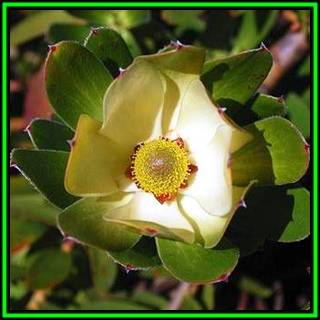
Leucadendron strobilinum - 10 Seed Pack - Endemic Shrub Protea Evergreen Cut Flower Fynbos - New
Check my rate
| Main centres: | 1-3 business days |
| Regional areas: | 3-4 business days |
| Remote areas: | 3-5 business days |

| Main centres: | 1-3 business days |
| Regional areas: | 3-4 business days |
| Remote areas: | 3-5 business days |
Leucadendron is a South African endemic genus in the Protea family, Proteaceae. The genus consists of about 80 species of evergreen shrubs and small trees. They are a prominent part of the fynbos ecoregion and vegetation type. Most species are shrubs that grow up to 1 m tall, some to 2 or 3 m. A few grow into moderate-sized trees up to 16 m tall. The leaves are spirally arranged, simple, entire, and usually green, often covered with a waxy bloom, and in the case of the Silvertree, with a distinct silvery tone produced by dense, straight, silky hairs. This inspired the generic name Leucadendron, which literally means "white tree". The flowers are produced in dense inflorescences; they are dioecious, with separate male and female plants. The seed heads, or infructescences, of Leucadendron are woody cone-like structures. This gave rise to their generic common name cone-bush. They are prized for their exotic-looking attractive flowers, cones and foliage. Leucadendron blossoms make excellent cut flowers, keeping their gorgeous red, burgundy, green or yellow color for up to three weeks. In the garden they do well in rockeries and also make excellent feature plants.
Leucadendron strobilinum commonly known as Mountain Rose, Peninsula Conebush or Rock Conebush in English and Bergroos or Rots-tolbos in Afrikaans is a South African endemic species found in the Western Cape Province. You will find it in the Cape Peninsula in forests and among fynbos. Leucadendron strobilinum is a large, single-stemmed shrub that branches from the base. It grows up to 2.6 m tall. The leaves are dark green and oval. The leaf tips are red and recurved with a fine point. The fruiting cones are ovoid and hairless and contain flat, winged seeds. It flowers from September–October.
|